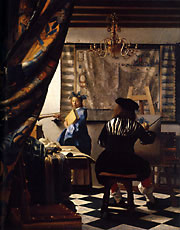

Examples:

Unsigned, Lighthouse at Inspiration Point, 1951,
paint-by-number, 16 x 20 inches, painted from an early set published
by Palmer. See details 1
and 2.
Unsigned, French Cathedral and Market, paint-by-number, 11 x 15 inches (frame 15 x 18 inches).

Unsigned, After Pinkie by Sir Thomas Lawrence (British,
1769-1830), paint-by-number, 16 x 20 inches. See a detail. The original version of this
"reproduction"
painting is in the collection of the Huntington Gallery, CA.
See Romanticism.

C. E. Gries, Jr., A European coach being
pulled by four horses going through a forest with a castle in
the background, undated, paint-by-number, 18 x 24 inches.
See a detail.
It is signed by Mr. Gries —
"the painter" — in the lower left corner.

Andy Warhol (American, 1928?1930?-1987),
Do-It-Yourself
Seascape J, 1963, oil
on canvas. By the 1960s
the popularity of paint-by-numbers had thoroughly dismayed art critics — just the
thing to tempt Andy Warhol to embrace it as Pop Art subject
matter. To produce this picture, Warhol projected
the line art from a paint-by-numbers
kit onto a large canvas
before painting.

American, Paint-by-Numbers Plan for
Vermeer's The Artist's Studio.
The major advertising company
of Young and Rubicam used this drawing
for a magazine advertisement
in promoting their own firm, 18 x 28 cms, October 1964. Jan Vermeer
(Dutch, Delft, 1632-1675). Below is the original
from which this drawing
was derived.

Johannes Vermeer (Dutch, 1632-1675), Allegory
of Painting (The Painter in His Studio), c. 1666, oil on canvas,
130 x 110 cm, Kunsthistorisches Museum, Vienna. The model personifies
Clio, Muse of History,
holding the trumpet of fame in her right hand and the chronicle
of world events in her left. Attributes
of other muses, including a mask,
lie on the table. These make the painter a narrator of stories.
See studio.
Also see after, analogy, appropriation, bad art, buckeye, calendar painting, copyright, droit moral, ersatz, kitsch, likeness, low art, obsession, originality, popular culture, print, simile, and simulacrum.
https://inform.quest/_art